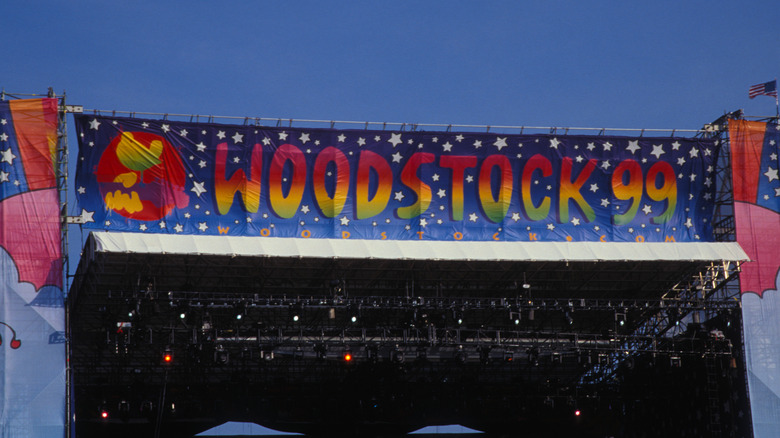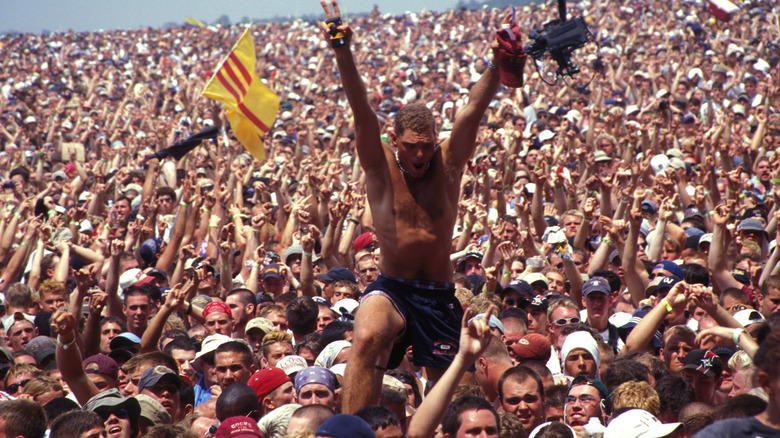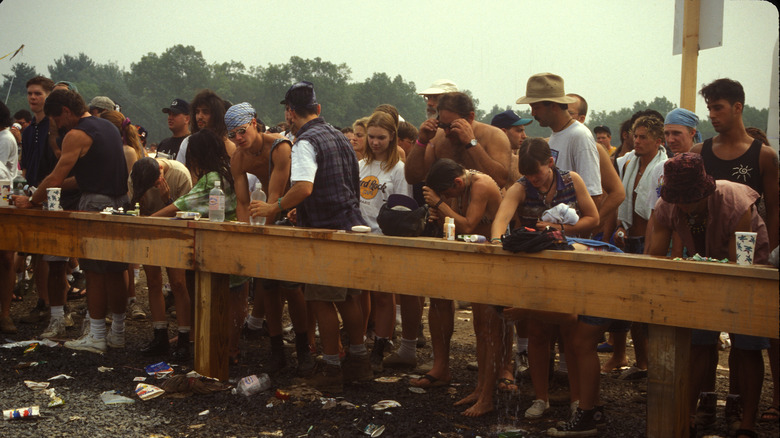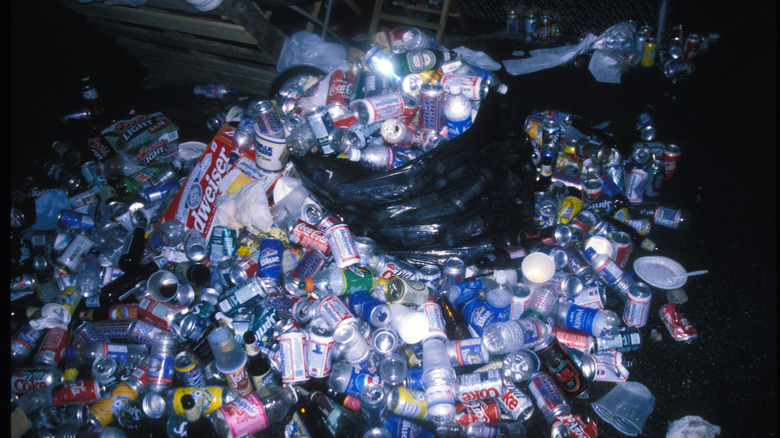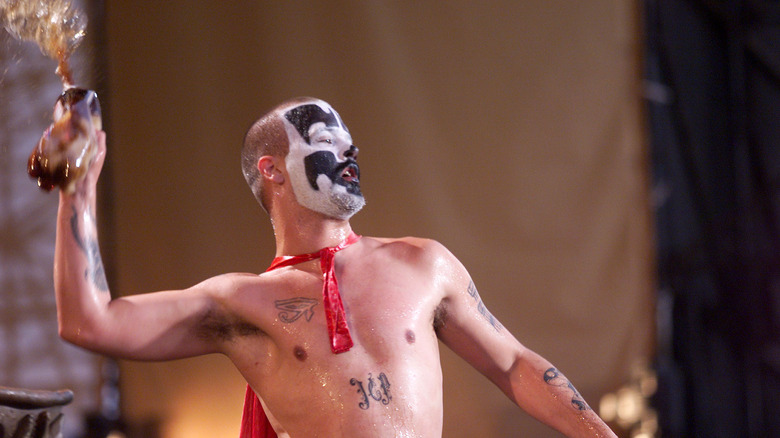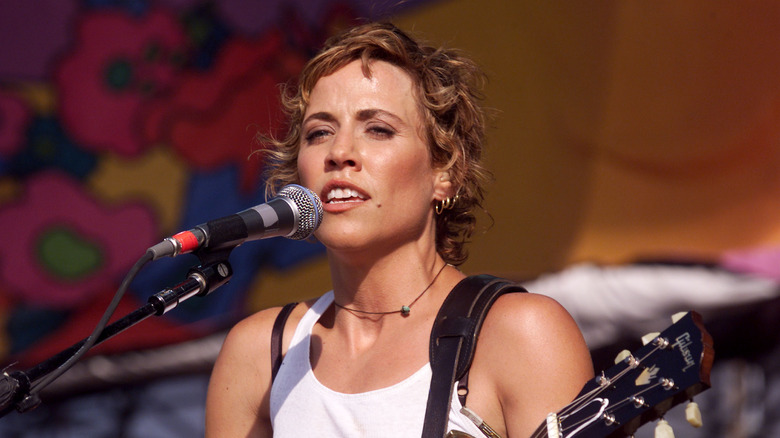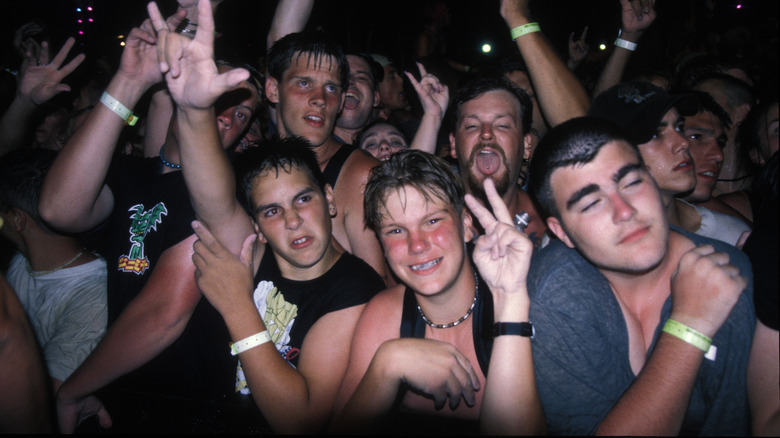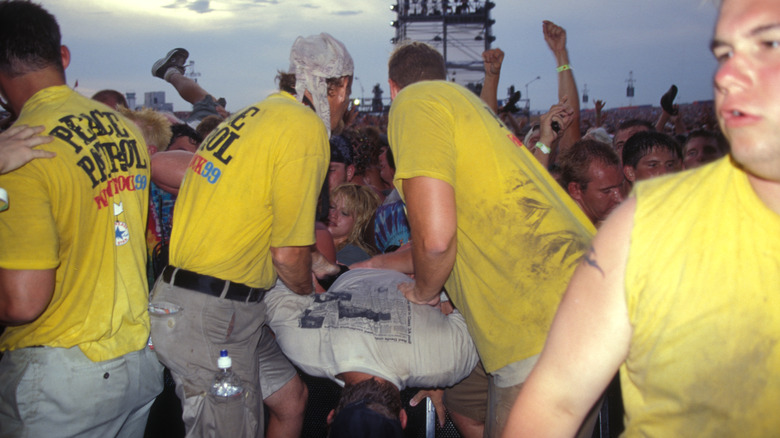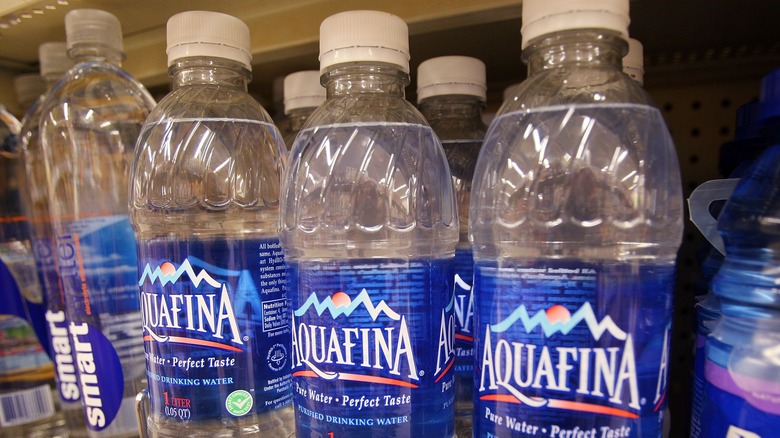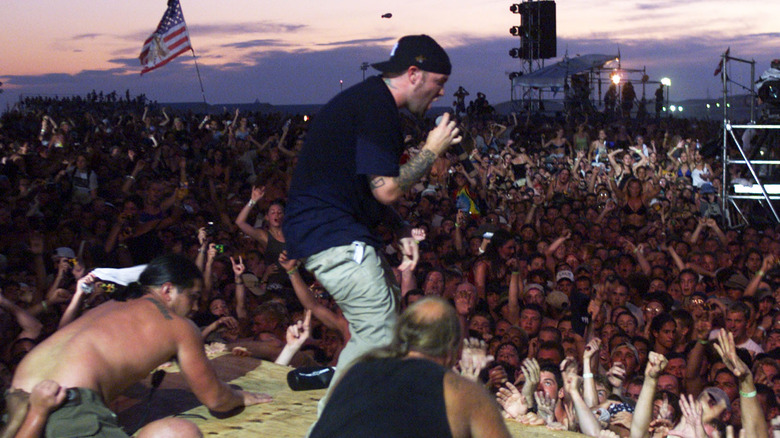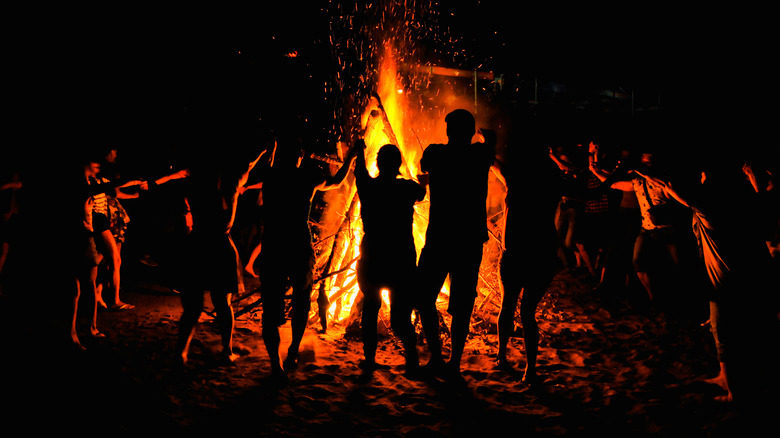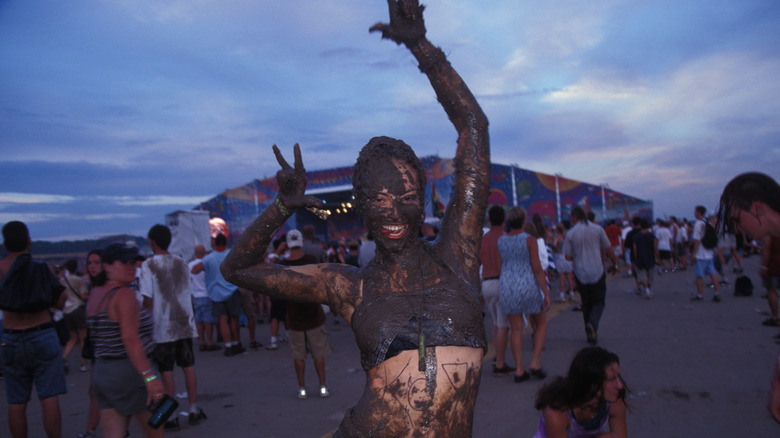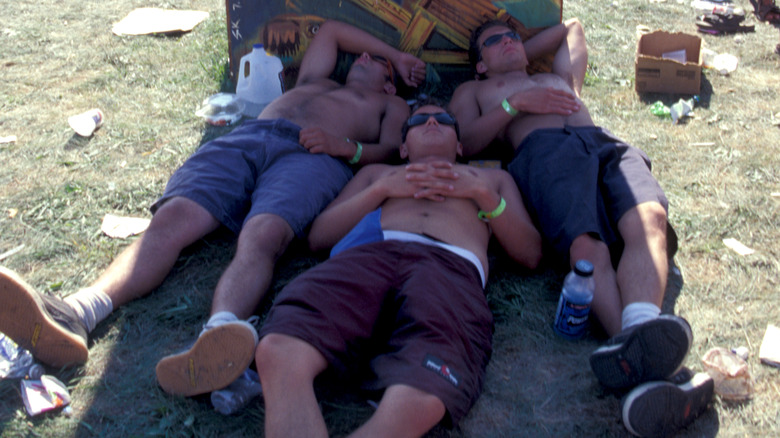Messed Up Things That Happened At Woodstock '99
1969's Woodstock Music Festival is an iconic 1960s moment — so iconic that to this day you can append "-stock" to just about any phrase in order to name a musical or cultural event. Originally planned as an event for about 50,000 people, poor planning and word-of-mouth transformed it into a cultural milestone that attracted more than 400,000 to a tiny farm in southern New York.
Ever since, people have sought to recapture that magic. There was a 20th-anniversary concert staged in 1989 (often referred to as "the forgotten Woodstock") and a 25th-anniversary festival put together in 1994 that devolved into a fair bit of mud-throwing, security-failing chaos. All the potential lessons of that 1994 concert were completely ignored five years later, however, when the notorious Woodstock '99 was announced. Not only were the logistics of the 1999 festival shaky from the beginning, but the world had changed dramatically in the three decades since the original.
While the more recent Fyre Festival has become the go-to reference for a poorly planned, disastrously executed music festival, Woodstock '99 was bigger — and worse – in just about every way. It was so bad that according to the San Francisco Examiner, people now look back and wonder if it was the beginning of rock and roll's decline as the dominant form of pop music in the U.S. How bad was it? Here are the messed up things that happened at Woodstock '99.
Woodstock '99 got insanely overcrowded
Despite the fact that previous Woodstock-style festivals had quickly devolved into a "Mad Max"-style free-for-all when it came to attendance, the organizers of Woodstock '99 thought they could handle it. They serenely capped ticket sales at 250,000 – still an enormous number of people — but as Rolling Stone points out, in the era before microchips and other modern ticket security features, it was incredibly easy to produce counterfeit tickets. That, combined with the exorbitant prices (tickets ranged from $157 to $180, which would be about $250 to $300 today) inspired a lot of people to crash the party.
How many? According to Syracuse.com, up to 400,000 people crammed into the festival before it was over. We'll never know for sure how many people showed up because of the ensuing chaos.
The overcrowding impacted every aspect of the show, from the water and food supplies to the available accommodations – every nearby hotel was booked solid (in part because a Baseball Hall of Fame ceremony was happening that same weekend), leaving many to roast in the sun all day without any sort of shelter. As noted by Festival Sherpa, the lack of organization, exacerbated by the sheer size of the crowd, instilled a sense of anger in the concertgoers, who began to act out with vandalism and violence to express their dissatisfaction.
There wasn't enough water
Even if the organizers of Woodstock '99 had managed the crowd effectively and kept the number of attendees down to the expected 250,000, there still would have been a huge problem: water. Or, more accurately, the lack of it.
As noted by Rolling Stone, Woodstock '99 was staged at Griffiss Air Force Base near Rome, New York, which was a terrible choice because it was a very hot day — temperatures spiked towards 100 at times. Without shade or grass, the base became an oven for the hundreds of thousands of people crammed into it — most of whom failed to bring their own water.
SPIN notes that there were free water spigots available — but not enough of them, and they were located far away from the stages, forcing thirsty folks to walk through the heat and crowds. That forced most of the attendees to buy water bottles from vendors at murderously high prices — $4 a bottle, which would be close to $7 in today's money. To put that into context, you can buy 24 bottles of water for about $5 today.
This all got so much worse when the crowd turned angry and violent. Many of the free water spigots were purposefully broken, which not only turned the whole place into a field of toxic mud but also deprived the crowd of any free water at all.
The incredible amount of garbage
In general, hot days plus huge piles of garbage are never a good combination. At Woodstock '99, this axiom was proved several times over, because things got disgusting fast.
It seems pretty obvious that wherever people go, they generate trash. Somewhere between 250,000 and 400,000 people converged on Rome, New York, to attend the festival. As reported by SPIN, trash collection was almost nonexistent, and most of the trash could be found littering the ground. As the crowd grew increasingly restless and violent, that trash was frequently used as projectiles, spreading it even further. The Washington Post notes that later, that garbage cans were overturned and dumped on the ground so they could be used as ersatz drums.
As Buzzfeed notes, that also meant that many of the exhausted, sun-baked concertgoers found themselves literally sleeping on top of garbage, because the entire venue had become an enormous garbage dump. The contractor in charge of cleaning the site during and after the event notes that they were limited to cleanup between the hours of 4 a.m. and 9 a.m. each day, and it simply wasn't enough time to deal with the volume. After the riots and fires broke out, trash collection was impossible — and the whole site later had to be cleaned up by hand in order to avoid damaging the grounds. The whole process took four weeks and collected 1,261 tons of solid waste.
Insane Clown Posse's money toss
In a lot of ways, Woodstock '99 was a lesson in late-stage capitalism run amok. First, crowd far too many people into a venue not equipped to handle that many people, and then overcharge for literally everything. From $4 bottles of water to $12 personal pizzas, the crowd at Woodstock '99 quickly figured out that they'd been fed into a machine designed to extract money from their pockets.
So it's kind of incredible that Insane Clown Posse decided to taunt the crowd with money. If you've forgotten all about ICP and the Juggalos who worship them, no one would blame you — though NPR reports that Juggalos were designated a "loosely organized hybrid gang" in 2011, and the band continues to release new music regularly. At Woodstock '99, ICP pulled a stunt that the San Francisco Examiner says "started the ball rolling" for the riots that later broke out. As reported by The Ringer, they taped $100 bills to dodgeballs and started tossing them into the crowd.
Naturally, a ruckus broke out as the hot and thirsty crowd fought over the money, each bill representing 25 life-giving bottles of water. When ICP ran out of $100 bills, they taped $500 to some more balls and kept the chaos going from the safety of the stage behind security.
The theme of the concert was sexual harassment
There's a reason Sheryl Crow considers Woodstock '99 to be the worst gig she's ever played, according to Yahoo Entertainment. In the middle of her set, a large crowd of guys began heckling her with a phrase that was repeated constantly throughout the festival: "Show your t*ts!"
Being a woman at Woodstock '99 must have been terrifying, because, as noted by Rolling Stone, there's no shortage of stories about women being catcalled, verbally abused, and intimidated. Being a celebrity was no protection — in addition to Crow's experience, actress Rosie Perez was also hit with that charming phrase about her chest, to which she quipped "$3.99, Blockbuster, go rent 'Do the Right Thing.'"
What's truly kind of horrifying about the general tone of misogyny and rape culture at Woodstock '99 is that it was officially sanctioned. As noted by MTV, the official Woodstock '99 website began posting photos of shirtless women, along with some pretty gross and immature captions. The idiots chanting stuff and abusing women at the concert were being encouraging by the promoters, and the cameras were happily capturing every awful moment for the entertainment value.
There were multiple sexual assaults
Considering the general — and encouraged — atmosphere of frat-boy misogyny on display throughout Woodstock '99, it isn't much of a surprise that there were several incidents of flat-out sexual assault during the event — and probably more than we'll ever know.
As The Ringer notes, women attending Woodstock '99 knew almost immediately they were in an unsafe environment — one woman recalls hearing obscene shouts and feeling a frat-like vibe at the camping sites set up around the venue. Several witnesses saw women being pulled into mosh pits and sexually assaulted, and The New York Times reports that four official accusations of rape emerged from the debacle, though many believe the number of assaults was much higher. One EMT reported that he was instructed to stand guard over a teenage girl as she waited for a nurse — because it was dangerous to leave her alone.
The most disturbing aspect of these reports is the apathy and lack of response. According to The Washington Post, these assaults were conducted in broad daylight, in full view of a crowd of hundreds of thousands — yet apparently there were few efforts to rescue anyone or to stop the violence. To be fair, the sheer density of the crowd may have prevented such attempts.
If you or anyone you know has been a victim of sexual assault, help is available. Visit the Rape, Abuse & Incest National Network website or contact RAINN's National Helpline at 1-800-656-HOPE (4673).
Security abandoned their posts
Ask yourself: If you have somewhere close to 400,000 people crammed into a hot, uncomfortable place, how many police officers would you need to keep order? If you answered about 500, you're delusional — but according to Rolling Stone, that's about how many cops were brought in to keep the peace at Woodstock '99. And we know how well that worked out.
To be fair, the organizers knew that 500 cops weren't enough, so they arranged for volunteer security workers to supplement the police. According to Vice, they also hired security workers — but then didn't train them much. Security quickly became overwhelmed when the huge crowd turned violent. On top of that, RNZ reports that many of the security guards were fired right before the event because of their behavior. Finally, there was no plan for security to access the stages. When things took a turn for the alarming, even the security on hand had no way to get through the crowd to the spots where trouble was brewing.
And as a final nail in the security situation's coffin, Rolling Stone notes that most of the volunteers brought in to supplement security simply walked off the job once inside, blending in with the crowd and vanishing, possibly because they were given "dilapidated" accommodations (per RNZ). The end result? When the riots broke out, there was almost zero security presence to stem it.
The price gouging at Woodstock '99
The legacy of Woodstock '69 was always imagined to be peace, love, and music, but Woodstock '99 was a for-profit, corporate-sponsored mess that was engineered from the very beginning to bleed its young audience dry.
It started with the ticket prices, which Rolling Stone notes started at $157 and then rose to $180 as the festival date approached. That attitude of gouging the fans for every red cent was carried over to the food and water sold at the concert. While it's true that every mass event makes a lot of money on the markup for food and drink, Woodstock '99 put on a master class by charging too much for everything. As Ultimate Classic Rock reports, that includes $4 bottles of water (nearly as expensive as the $5 beers), $12 for tiny "personal" pizzas, $10 for a burrito — and in perhaps the greediest insult of all, a whopping $15 for a bag of ice. Because the event was so remote, there were no alternative places to purchase anything.
MTV notes that the high cost of everything rankled concertgoers because everyone had already spent so much on the pricey tickets, gas and transportation, and hotel rooms if they could get one. Literally everything cost money, and too much of it. According to The New York Times, many attendees later claimed that the violence and looting which closed out the festival were in part inspired by the oppressive greed on display.
Fred Durst of Limp Bizkit egged the crowd on
Someday, we'll have a national reckoning concerning the mysterious popularity of Limp Bizkit. (Lest we forget, their third album, "Chocolate Starfish and the Hot Dog Flavored Water," debuted at Number 1 in 2000 with first-week sales of more than a million copies.) But in 1999, they were undoubtedly one of the main attractions at Woodstock '99, and lead singer Fred Durst did his level best to make a bad situation much, much worse.
As reported by the San Francisco Examiner, the festival's organizers could see that the crowd's mood was turning ugly, so they asked Durst to try to calm the situation. He promptly went out onstage and did the literal opposite, shouting, "I don't think you should mellow out. This is 1999, motherf*ckers — stick those Birkenstocks up your a**!" The band then launched into one of their biggest hits, a song called "Break Stuff."
As The Ringer notes, Limp Bizkit is often mistakenly blamed for directly starting the riots that closed out Woodstock '99, but this is inaccurate — the fires and vandalism didn't break out fully during Limp Bizkit's performance. But as promoter John Scher notes, Durst was a "cheerleader" for the chaos, and his speech and the band's performance of an incendiary song that celebrates violence no doubt increased the likelihood of the festival ending in flames.
The riots at Woodstock '99
If Woodstock '99 has a legacy, it's undoubtedly the images of young kids setting fires, smashing equipment, and fighting. When you think Woodstock '69, you might think about free love and hippies. When you think of Woodstock '99, you think about riots.
While the San Francisco Examiner notes that Insane Clown Posse began the process of agitating everyone when they tossed dodgeballs with $100 bills taped on them into the crowd, and Fred Durst of Limp Bizkit undoubtedly made things exponentially worse when he egged on the growing violence, Rolling Stone argues that it was the Red Hot Chili Peppers' performance of Jimi Hendrix's "Fire" that finally set off the epic chaos. The song choice was supposed to honor the legacy of Woodstock '69, but instead it put an idea in everyone's head. And as poor planning would have it, an activist group had passed out "peace candles" just before. It was almost as if the organizers wanted everything to end in fire and vandalism.
The kids went berserk. Fires were set, trucks and other vehicles were overturned, and SPIN reports that injuries like broken limbs, collarbones, and noses were distressingly common. The First-Aid tent was soon overwhelmed, and people began throwing rocks and bottles. Woodstock '99 was never going to be remembered as a tribute to planning and logistics, but now it would forever be known for violence and property damage.
The Mud People
According to SPIN, sanitation at Woodstock '99 left something to be desired ... okay, literally everything to be desired. There was insufficient water and, as MTV notes, not nearly enough portable toilets for the estimated 400,000 people in attendance — and those portable toilets were never emptied. It's easy to see how the heat, the grime, and the mounting piles of garbage inspired a sense of societal collapse.
It also inspired one of the most messed-up moments at Woodstock '99: the emergence of the Mud People.
As RNZ explains, at some point, a group of people in the crowd broke one of the water mains and created a massive mud pit that mingled freely with the overflow from the portable toilets — and then dived in and covered themselves in it. Jamiroquai's Jeff Kay exhorted the crowd to throw clumps of the stuff — and they complied with gusto. And the Mud People were aggressive about recruitment, throwing mud at others as they passed by and trying to drag them into the mud when they came desperately searching for water in the hot weather. It very much wasn't a group of kids having a blast in the mud. It was a weird, ominous sign that everything was breaking down.
People got hurt — and 3 people died
Ultimately, the most messed up things that happened at Woodstock '99 are undoubtedly the many sexual assaults and serious injuries people suffered — many of which could have been avoided if the festival had been planned better and if security had been more effectively trained.
As noted by Syracuse.com, the most common problem was heat exhaustion and dehydration spurred by intense heat that approached 100 degrees and a lack of easily accessible water. Hundreds of people were treated for heat-related problems — and according to MTV, two people died from heat-related issues. A third person died when she was hit two separate cars while walking on a nearby road after her car broke down.
There were multiple other injuries. MTV reports hundreds of trauma-related injuries, including broken bones, suffered during the chaotic performances of bands like Limp Bizkit and during the hectic riots that closed out the festival. SPIN reports there were broken arms, broken legs, broken noses, broken ribs, and even a compression fracture to someone's spine. The EMTs working at the festival's first-aid tent were overwhelmed — at one point, they were treating 200 people an hour. Ultimately, more than 100 concertgoers wound up in local hospitals, some with serious injuries.
